This painting features numerous couples in love. Together they sit or stroll in a landscape that is depicted with a loose brushstroke and is immersed in a particularly beautiful evening light. The scene is dominated by a statue of the love goddess Venus, which can be seen on the right side of the picture. The goddess is taking the quiver and arrows away from her son Cupid – obviously he has already shot enough of them, causing people to fall passionately in love with each other.
Further Media
The parkland setting may look very natural, yet at the same time, the scenery has something exceptionally artificial. Don’t the figures in the foreground seem rather like actors on the stage? Couldn’t the distant landscape be just a theatre backdrop? It is not exactly clear where reality stops and the game of courtship begins. Here, quite possibly, we are not looking at a real event, but a stage performance.
There is undoubtedly a connection to the theatre, since the genre of the fête galante was heavily influenced by the traditional form of improvised theatre in Italy – the commedia dell’arte. The commedia dell’arte figures and costumes were exceptionally popular in eighteenth-century Paris.
The colourful ambiguity is, in any case, a main feature of rococo art, a stylistic era roughly between 1710 and 1770.
- Location & Dating
- 1718/19
- Material & Technique
- Oil on canvas
- Dimenions
- 61,3 x 75,2 cm
- Museum
- Gemäldegalerie Alte Meister
- Inventory number
- Gal.-Nr. 782

